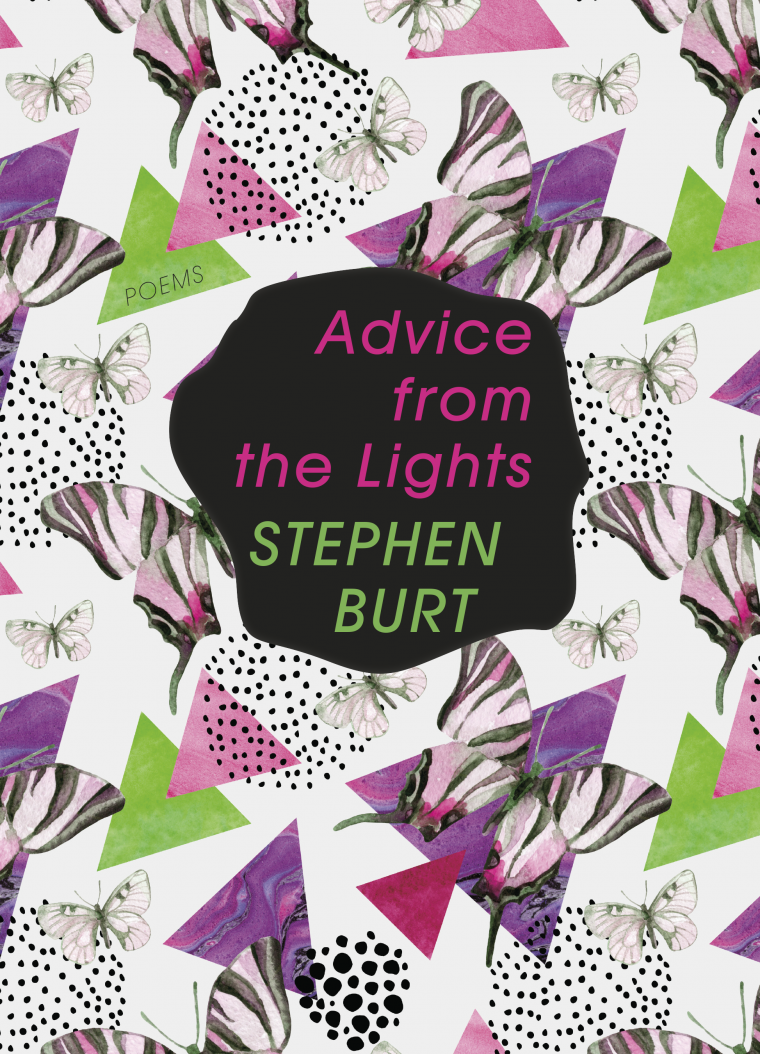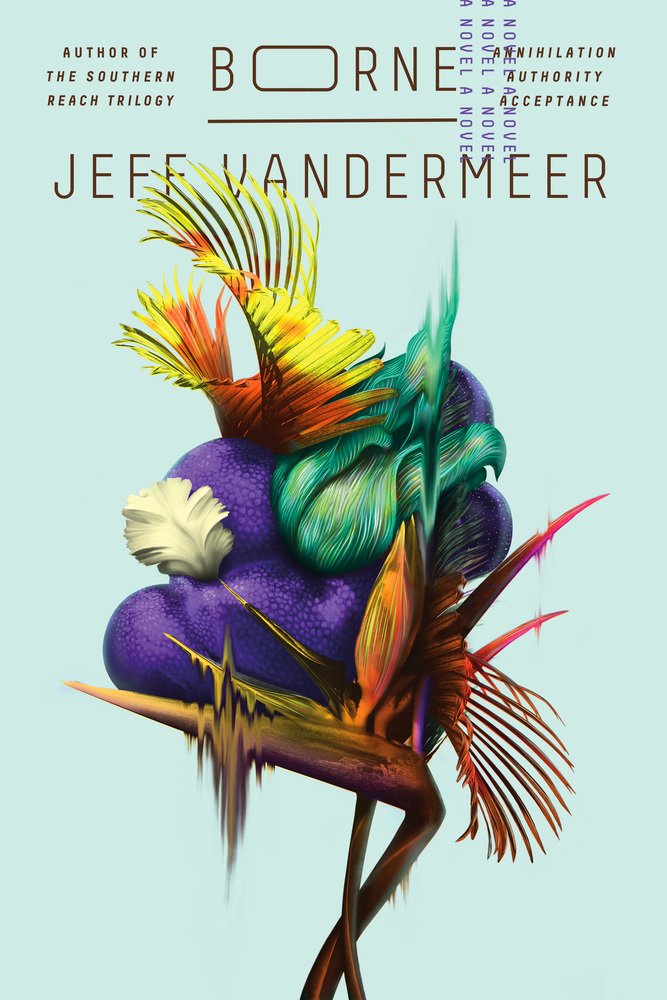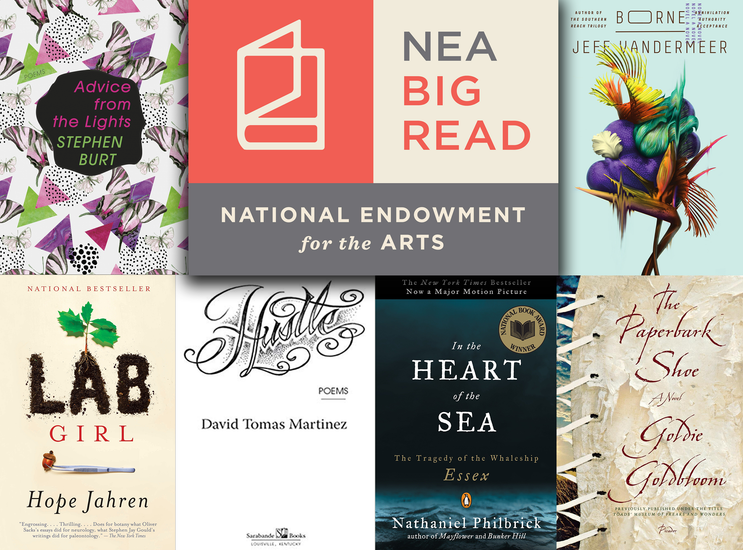2019 NEA Big Read Webinar Recap
Posted by Karlyn Hixson on Nov 20, 2018
The NEA Adds 6 New Titles to its Big Read Library for 2019
Attending this year's NEA Big Read Webinar was just as fascinating, intriguing, and informative as we've come to expect from this incredible team. Amy Stoll, Lauren Miller, and Josh Feist led us through an overview of the Big Read program, including the history of the program, the six new titles added to the Big Read Library for 2019, criteria applied to new selections, and in-depth author perspectives of their new titles, complete with programming ideas. A big thank you to the NEA Big Read team for taking the time to enlighten and educate us all about this wonderful program.
About the NEA Big Read Program:
Since 2006, more than $19 million in grants have been awarded to more than 1,400 Big Read programs in every district in the country. The 12-year history of the NEA Big Read program boasts a staggering $44 million in local funding to make these programs a reality, with over 5.2 million Americans in attendance, over 89,000 volunteers, and more than 40,000 community partner organizations. Each year, the NEA Big Read program grants approximately 75 organizations nationwide with anywhere between $5,000 and $15,000 each to run their respective month-long Big Read Programs.
How are books selected for the NEA Big Read library?
First, submitted books are judged on their capacity to:
• incite lively and deep discussion (if you know of a title to suggest, don't hesitate to do so!)
• expand the range of voices, stories, and genres currently represented in Big Read library
• interest lapsed and/or reluctant readers, and to challenge avid readers and introduce them to new voices
• inspire innovative programming for communities
Once these criteria are assessed for each submitted titles, the committee—made up of booksellers, librarians, past grantees—read all of the submissions to further assess the titles. American authors are given some level of preference in order to reach the American communities and future readers these books will be serving in their Big Read programs. It also helps if authors are willing and able to travel to some of these communities that will be choosing their titles for Big Read programming.
What are the new books added this year?
In addition to six new titles, the NEA has also brought back two titles from the archive: Fahrenheit 451 and Our Town. Without further adieu, here are the newest titles added to the NEA Big Read library:
 In the Heart of the Sea, covers a true story (which actually inspired Moby Dick) of the whaleship, Essex. From the National Book Award winning author of Mayflower and the forthcoming Valiant Ambition, Nathaniel Philbrick's book is a fantastic saga of survival and adventure, steeped in the lore of whaling, with deep resonance in American literature and history.
In the Heart of the Sea, covers a true story (which actually inspired Moby Dick) of the whaleship, Essex. From the National Book Award winning author of Mayflower and the forthcoming Valiant Ambition, Nathaniel Philbrick's book is a fantastic saga of survival and adventure, steeped in the lore of whaling, with deep resonance in American literature and history.
In 1820, the whaleship Essex was rammed and sunk by an angry sperm whale, leaving the desperate crew drifting for more than ninety days in three tiny boats. Added to the NEA Big Read Library to show how a contemporary story can tie back to a classic, this book is sure to spark discussion of lesser-known events in today's history. Nathaniel Philbrick uses little-known documents and vivid details about the Nantucket whaling tradition to reveal the chilling facts of this infamous maritime disaster. In the Heart of the Sea, recently adapted into a major feature film starring Chris Hemsworth, is a book for the ages.
 Advice from the Lights is a brilliant collection of poems featuring a candid exploration of and discussion about gender and identity. Stephen is sometimes Stephanie and sometimes wonders how his past and her past are their own collective memory.
Advice from the Lights is a brilliant collection of poems featuring a candid exploration of and discussion about gender and identity. Stephen is sometimes Stephanie and sometimes wonders how his past and her past are their own collective memory.
It's part nostalgia, part confusion, and part an ongoing wondering: How do any of us achieve adulthood? And why would we want to, if we had the choice? This collection is woven from and interrupted by extraordinary sequences, including Stephanie poems about Stephen’s female self; poems on particular years of the poet’s early life, and versions of poems by the Greek poet Callimachus, whose present-day incarnation worries (who doesn’t?) about mortality, the favor of the gods, and the career of Taylor Swift.
This book will appeal to adults and young adults and could be read as short monologues in a theatrical setting as a possible Big Read programming event. Don't miss this author's 2014 Ted Talk, Why People Need Poetry.
 Geobiologist Hope Jahren has spent her life studying trees, flowers, seeds, and soil. Lab Girl is her revelatory treatise on plant life—but it is also a celebration of the lifelong curiosity, humility, and passion that drive every scientist. In these pages, Hope takes us back to her Minnesota childhood, where she spent hours in unfettered play in her father’s college laboratory. She tells us how she found a sanctuary in science, learning to perform lab work “with both the heart and the hands.” She introduces us to Bill, her brilliant, eccentric lab manager. And she extends the mantle of scientist to each one of her readers, inviting us to join her in observing and protecting our environment.
Geobiologist Hope Jahren has spent her life studying trees, flowers, seeds, and soil. Lab Girl is her revelatory treatise on plant life—but it is also a celebration of the lifelong curiosity, humility, and passion that drive every scientist. In these pages, Hope takes us back to her Minnesota childhood, where she spent hours in unfettered play in her father’s college laboratory. She tells us how she found a sanctuary in science, learning to perform lab work “with both the heart and the hands.” She introduces us to Bill, her brilliant, eccentric lab manager. And she extends the mantle of scientist to each one of her readers, inviting us to join her in observing and protecting our environment.
Named one of the Best Books of the Year, this book uniquely presents the obstacles and triumphs of being a female scientist and allows for the possibility of connection with schools and local science programs for Big Read programming. There is also potential to work with such organizations as The Boys and Girls Club, and as a side note, this title has been selected for First Year Experience reading by the following schools: University of California—Santa Barbara, Missouri State University, University of Massachusetts—Amherst, and The University of Virginia.
 From 1941 to 1947, eighteen thousand Italian prisoners of war were sent to Australia. The Italian surrender that followed the downfall of Mussolini had created a novel circumstance: prisoners who theoretically were no longer enemies. Many of these exiles were sent to work on isolated farms, unguarded.
From 1941 to 1947, eighteen thousand Italian prisoners of war were sent to Australia. The Italian surrender that followed the downfall of Mussolini had created a novel circumstance: prisoners who theoretically were no longer enemies. Many of these exiles were sent to work on isolated farms, unguarded.
The Paperbark Shoe, set during World War II and based on true history, is the unforgettable story of Gin Boyle—an albino, a classically trained pianist, and a woman with a painful past. Disavowed by her wealthy stepfather, her unlikely savior is the farmer, Mr. Toad―a little man with a taste for women's corsets. Together with their two children, they weather the hardship of rural life and the mockery of their neighbors. But with the arrival of two Italian prisoners of war, their lives are turned upside down. The Paperbark Shoe is a remarkable novel about the far-reaching repercussions of war, the subtle violence of displacement, and what it means to live as a captive―in enemy country, and in one's own skin.
Winner of the 2008 AWP Award for the Novel, this wonderful new addition to the NEA Big Read library also has pieces of music available to accompany the novel (which will be added to the NEA Big Read website soon!), and a new blog post Q&A with the author, Goldie Goldbloom.
 Named one of the best books of 2017, Borne centers around a young woman named Rachel who survives as a scavenger in a ruined city half destroyed by drought and conflict. The city is dangerous, littered with discarded experiments from the Company—a biotech firm now derelict—and punished by the unpredictable predations of a giant bear. Rachel ekes out an existence in the shelter of a run-down sanctuary she shares with her partner, Wick, who deals his own homegrown psychoactive biotech.
Named one of the best books of 2017, Borne centers around a young woman named Rachel who survives as a scavenger in a ruined city half destroyed by drought and conflict. The city is dangerous, littered with discarded experiments from the Company—a biotech firm now derelict—and punished by the unpredictable predations of a giant bear. Rachel ekes out an existence in the shelter of a run-down sanctuary she shares with her partner, Wick, who deals his own homegrown psychoactive biotech.
One day, Rachel finds Borne during a scavenging mission and takes him home. Borne as salvage is little more than a green lump―plant or animal?―but exudes a strange charisma. There is an attachment she resents: in this world, any weakness can kill you. Yet, against her instincts―and definitely against Wick’s wishes―Rachel keeps Borne.
This book will have wide appeal and potential cross-promotional opportunities with STEM programs in local schools since it centers on the intersection of nature and technology. As shared on the webinar, there are opportunities to do Big Read programs around Earth Day, even perhaps partnering with local zoos, in addition to fun programming with graphic art contests asking individuals to turn in their interpretations of the hybrid creatures presented in the novel.
In this debut poetry collection, Martinez translates the unique nature of his autobiography with an acute ear for rhythm, transporting readers from barrio alleyways to the shipyards of San Diego to the halls of Houston academia; broaching such topics as young fatherhood, gang life, and stereotypical masculinity with refreshing candor and linguistic savvy.
Hustle is a collection of poetry that will appeal to High School students and boys struggling with what it means to be a man. It's a good choice for those hesitate to read poetry as well.
"David Martinez is like an algebra problem invented by America—he's polynomial, and fractioned, full of identity variables and unsolved narrative coefficients. . . . Hustle is full of dashing nerve, linguistic flair, and unfakeable heart." —Tony Hoagland
Will I have a better chance of receiving the grant if I choose a new title?
The current library of 32 titles from NEA Big Read is still fair game and grantees will not be guaranteed to receive a grant by choosing one of the newest titles. The NEA encourages all grantees to select the title that they feel would be most appropriate, challenging, and inspiring to their respective communities. Be willing to revisit titles that are still in the library—sometimes new themes become relevant again depending on cultural shifts in society and in your own community.
Be sure to take careful consideration of each of these new titles, as well as all of the amazing titles in the entire library. For your application timeline, please be sure to visit either of these sites to learn more: Arts.gov/partnerships/nea-big-
What resources are available as I am applying for this grant?
There are lots of helpful questions and answers provided based on thousands of applications and questions asked in the process, and you can access examples of past recipients under the "Guidelines" page.
There is a survival guide which includes information about strategizing during the proposal phase. Information centered around partnerships, marketing, and promotion are also provided here. Once you submit your intent to apply, potential grantees will gain access to community discussion forum (another great community for connection and idea exchange for your Big Read program!).
Check out the NEA website for more information on partnerships you might consider for your upcoming Big Read Program: arts.gov/partnersips/nea-big-
We'd love to be of help to you in planning and ordering books for your upcoming NEA Big Read program. Please don't hesitate to reach out to us here: support [at] book-pal [dot] com!
This post was written by Karlyn Hixson, Marketing Director at BookPal. She is currently reading Unshakable Hope by Max Lucado.




